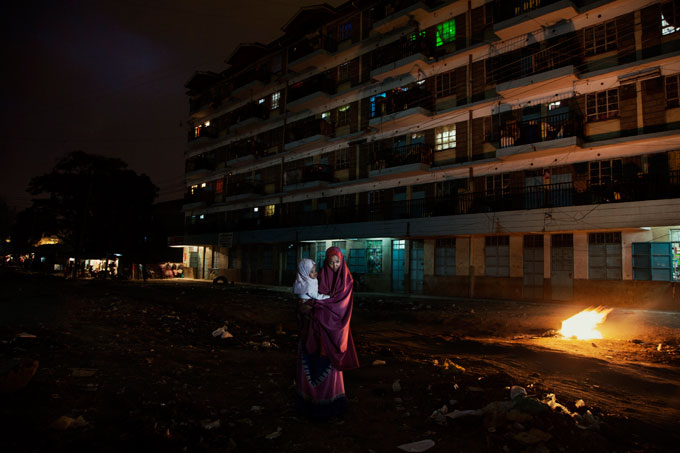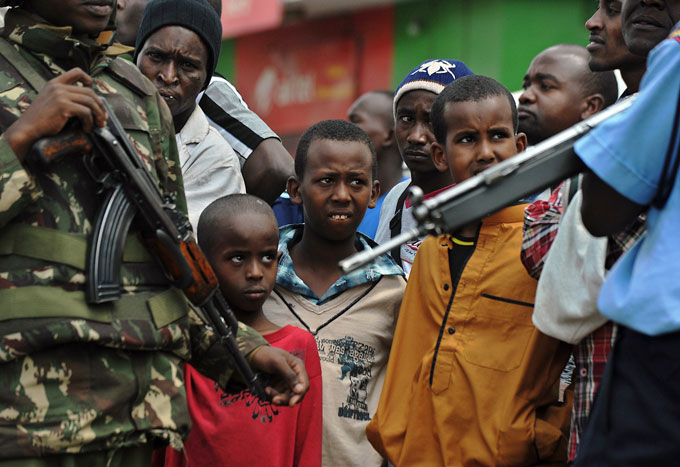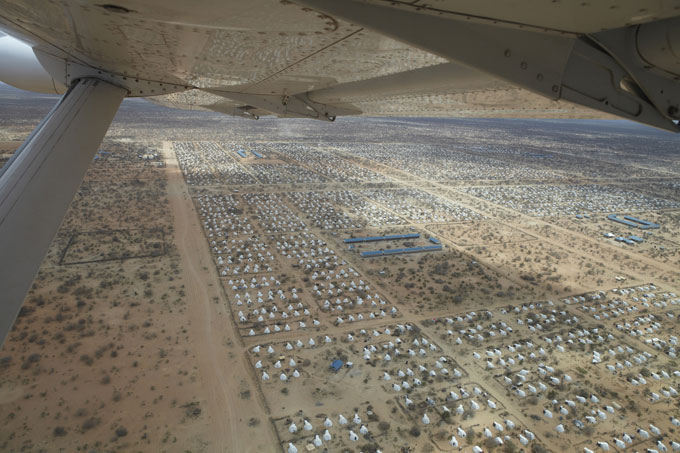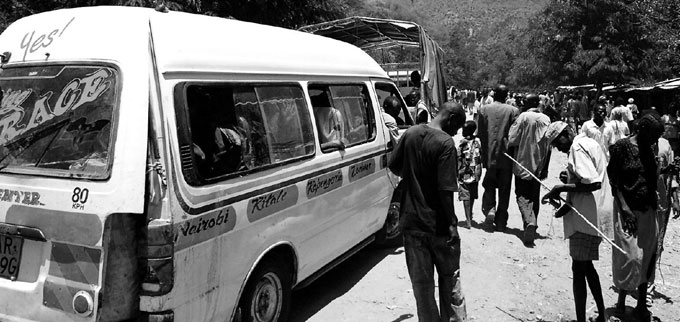
Somali refugee Iftin Ahmed Farah, 24, from Mogadishu pictured in the neighborhood of Eastleigh, in Nairobi, Kenya. Photo by flickr user European Commission DG ECHO. July 5, 2012.
Anab was home with her younger sister and their housekeeper when the police knocked on their door one evening around 5:30. Her mother and brothers had instructed her not to open it when they weren’t around. “But I had to,” she tells me, “they were banging the door like they were going to break it.” Three policemen asked to see their IDs. Those three were easily satisfied, but later that evening two different policemen came to the house. They too asked for IDs and then decided to search the house.
“I was scared there were rumors everywhere that police were raping women,” Anab recalls. She, her sister and their housekeeper stood in the hallway outside their apartment while the police searched.
The housekeeper mused aloud, “What if they steal?”
“What if they rape us?” Anab retorted. When the search turned up nothing, the police tried an age-old trope: “They asked for chai.”
I groan when she tells me this.
“Yeah. I played dumb,” laughs Anab. “I was like, chai? The tea from 4 p.m. is finished. You can wait, we cook some for you?”
Three more policemen arrived that evening, this group threatening to arrest Anab’s sister—a minor—unless of course the family was willing to part with some money. Anab managed to evade them too with some fast talk and was relieved when she finally closed the door behind them. But commotion in the hallway brought her outside again.
Anab’s neighbor, a Somali refugee, had permission to be in Kenya and was married to a Kenyan. Despite her papers and status, the police arrested her. The officers yelled at the woman, “You are the people blowing up our country.”
“What have I blown up?” the woman asked.
The raid on Anab’s home was part of Operation Usalama Watch or, as it was known in official government circles, “Operation Sanitization of Eastleigh,” a security crackdown on the predominantly Somali neighborhood in Nairobi where Anab’s family lives that started in April 2014. The Kenyan government billed it as a counterterror program after a wave of al-Shabaab attacks, including the high-profile assault on Nairobi’s Westgate Mall, hit the country. But the operation did not target terrorists; it scapegoated the Somali community as a whole.
The police, with the young wife trailing behind them, went on to the next two apartments. Both were also home to Somali refugees with UN papers. The officers threatened to arrest two of the female occupants, releasing them only when they offered bribes.

Police officers control a crowd near the scene of the inspection of a vehicle suspected to be packed with explosives in Nairobi’s Somali district of Eastleigh, April 24, 2014. Photo by Tony Karumba/AFP/Getty Images.
—
I meet Anab for the first time eight months after Operation Usalama Watch was rolled out, in December 2014. My friend Sally introduces us when we visit Anab’s family-run shop in Nairobi’s Eastleigh neighborhood, also known as Little Mogadishu. Sally lives in my old neighborhood on the edge of Eastleigh. Our short walk to the shop is marked by a sprawling rubbish dump and an open-air car wash serving the lorries and long-distance buses parked along the sides of the road. At the corner, just outside Pumwani Maternity Hospital, an informal market has sprung up to distribute the day’s shipment of khat from upcountry. Khat is embedded in the traditions and social life of some Kenyan communities, including Somali-Kenyans, but the mild stimulant—while legal, popular, and commercially important—is generally frowned upon by religious groups and the middle class. As we get closer and closer to Eastleigh proper, it becomes apparent that ethnic Somalis are a visible majority here.
Eastleigh malls are nothing like the malls in suburban Nairobi, let alone their American counterparts. There’s no dance of seduction, no beautifully adorned mannequins in picturesque storefront windows coaxing you to possess the fantasy life they represent. Here are all manner of cheap goods piled high with no veneer—not even glass windows. Money changes hands audibly as passersby purchase shoes, bags, underwear, baby formula, diapers, cosmetics, curtains, tools, suitcases—anything.
Sally’s eye veers to some navy blue pleather flats at the front of the store while I get to know Anab. Sally’s been buying bags and shoes from the family-run business for the last two years. Anab is in her early 20s, pretty, with an easy smile and the linguistic dexterity of young people in Nairobi, gliding smoothly between English and Swahili. When I stutter, trying to walk a line between serious and nonthreatening as I explain that I’m writing about Eastleigh, Anab cuts me off to tell me that she’s in college studying journalism. So I should relax and spell it out. I tell her I’m hoping to understand what it means to be an ethnic Somali living in Kenya right now—to understand the layers behind the NGO statistics, Twitter hashtags and news reports.
A customer choosing between the Tiffany blue and black versions of a handbag interrupts us. Anab attends to her while Sally negotiates prices with Anab’s mother, a serious woman with no time for loose talk. Anab’s brother, a tall, slim teenager in a checked button-down shirt, sees his chance to interest me in some shoes. I point at a royal blue faux-leather tote hanging on the back wall instead and step inside the tiny shop to give it a closer look. Smiling slightly, he waits for me to ask the inevitable “How much?”
In October 2011 Kenya invaded Somalia, ostensibly to push back al-Shabaab’s advances. Even then the Kenyan government seemed intent on conflating refugees in Kenya with terrorists: as al-Shabaab attacks in Kenya became more frequent, the government stopped registering urban asylum seekers, and it initiated a plan to move the country’s 55,000 urban refugees from cities to camps. Human rights organizations sued the government to stop the forced move, prevailing in court in July 2013. When al-Shabaab claimed responsibility for the attack on the Westgate Mall in September of that year, which claimed the lives of 67 people, government suspicion again turned on ethnic Somalis, even though the community itself was not spared the more minor grenade attacks that continued to rock the country after Westgate.
While ethnic Somalis had historically been pigeon-holed as bandits, warlords and pirates, now they were ATM machines–and al-Shabaab militants.
Operation Usalama Watch was launched in early April 2014 with the stated aim (PDF) to “arrest foreign nationals who were in the country unlawfully and anyone suspected of terrorist links.” Usalama is Swahili for safety or security, from the root word for peace.
The operation was anything but peaceful. At least 4,000 ethnic Somalis and foreign nationals from neighboring countries were arrested. When their numbers overwhelmed police stations, many were held at a sports stadium in Kasarani, in the outskirts of Nairobi. When images of the crowded and inhumane conditions at Kasarani, where adults and children alike were held for weeks without formal charges, began to circulate, the hashtag #KasaraniConcentrationCamp emerged on Twitter. Two thousand people were taken to the already overcrowded refugee camps, and more than 300 were deported to Mogadishu. And everywhere there were reports of police taking bribes to release documented and undocumented Kenyans and non-Kenyans alike. While ethnic Somalis had historically been pigeonholed as bandits, warlords and pirates, now they were ATM machines—and al-Shabaab militants.
Day 85, Somalis detained at #KasaraniConcentrationCamp as scapegoats for the failure of the security apparatus in KE pic.twitter.com/Whr1VUkzPf
— Nomad (@Hudheifa_Aden) June 25, 2014
America’s post-9/11 “war on terror” is a great inspiration for Kenya. In a statement following the recent attack at a Garissa university, in which al-Shabaab gunmen killed 147 people, Deputy President William Ruto said, “The way America changed after 9/11 is the way Kenya will change after Garissa.” But Kenya is already—and has for some time been—a place where historically underprivileged communities are further victimized by government security agencies—ironic, when those communities are also well placed to support efforts to catch genuine suspects.
—
There’s a sour history to the assimilation of Somali-Kenyans into the nation-state. In 1962 the British held a referendum that offered ethnic Somalis residing in northern Kenya a choice between joining Kenya or Somalia when Kenya became independent. An overwhelming majority voted to join Somalia, but that outcome was not honored, paving the way for the secessionist conflict now known as the Shifta (“Bandit”) War of 1963–67. State-sponsored violence against ethnic Somalis did not end there. In 1980 and 1984 government troops tortured and murdered an unknown number of ethnic Somali residents of Kenya. Government figures put the death toll of the 1984 Wagalla Massacre at 57, while eyewitnesses estimate close to 5,000. (One such witness, the Kenyan Al Jazeera journalist Mohammed Adow, was a boy when his family was displaced escaping the 1980 Garissa Massacre. His documentary Not Yet Kenyan takes stock of Kenya’s response to recent terror attacks while offering a personal account of the loss and resilience of Somali-Kenyans since the forming of Kenya.)
Somalia’s collapse in 1991 is a crucial part of the story: as civil war overtook the country, a stream of refugees poured into Kenya, many setting up camp at Dadaab, just outside Garissa, about 80 miles from the Kenya-Somali border. The Dadaab camp, established by the UN, was only ever meant to host 90,000 people, but by 2012, after a particularly bad famine struck the region, half a million refugees lived there, making it the largest refugee camp in the world. The predominantly Somali-Kenyan residents of the region bore the brunt of the environmental burden. Since 2011 they, together with the non-Somali minority, have also been the victims of numerous small-scale attacks by al-Shabaab, often in markets and churches—including the most recent attack, which killed 14 people this month in the northern town of Mandera. Indeed, that Garissa was the location of this April’s Easter Week attack at a Kenyan university was no surprise, given the number of attacks that this town and the surrounding region have already endured and given the porous border we share with Somalia even now, when we are at war. But the relative ease with which the ambitions of so many young people were snuffed out in this, al-Shabaab’s most deadly attack in Kenya, pierced the nation’s core.

Aerial photo of Dadaab refugee camp. Photo by flickr user Oxfam International. November 1, 2011.
Given this poor history, abuses of power during Operation Usalama Watch—documented by several sources—may seem unremarkable. In July 2014, three months after it kicked off, the Independent Police Oversight Authority (IPOA) published findings that police acted inappropriately during the raids. While the admission was commendable, that the IPOA sought to investigate just 29 officers on corruption charges also seemed true to our history of trying to minimalize the harm done by security agencies, and thus minimize the government’s culpability. The IPOA gave the inspector general 90 days to respond to the charges and act, but the time lapsed before he responded. The matter remains all but dead.
Operation Usalama Watch was no aberration but a continuation of practices that have endured into the present. A May 2013 report by Human Rights Watch, “You Are All Terrorists,” detailed the acts of brutality—which reportedly “included rape, beatings and kicking, theft, extortion, and arbitrary detention in inhuman and degrading conditions”—during a police operation that started a day after a terror attack in Eastleigh in November 2012. There were 1,000 people arrested then, and almost all the 101 who were interviewed by Human Rights Watch reported extortion. Fifty reported sexual abuse. Without significant changes in the way security agencies work during the three months in between the two operations, it isn’t a stretch of the imagination to presume that a report on Operation Usalama Watch would produce similar findings.
Nearly a year after Operation Usalama Watch, vivid stories about what happened during the raid continue to circulate in the Eastleigh community. Anab told me two: about how a pregnant woman panicked when police came to her house and fell from a balcony as she tried to escape, losing her baby. A second woman, a mother of a four-month-old baby, was arrested outside her house for not carrying her ID—with her baby still inside. Police would not let her back into her house or let her call a family member to care for the child, and during the week she was in custody, the baby died of starvation.
Anab sighs as she relates these stories from the neighborhood: “It doesn’t matter whether you are a Kenyan or not, whether you have an ID or not. That’s Kenya for us.”
Operation Usalama Watch held the country’s attention for two months. Many were critical of the manner in which it was executed, especially once it became clear that security forces were more interested in extorting money than in finding terrorists. Although the government called the operation a success, it did not offer details on any suspected terrorists the police had arrested or any weaponry they recovered. Indeed, all the data released concerned the nationality of those arrested rather than their terrorist links. A year after the IPOA report about the operation, the raids continue; away from public attention.
“Even if I take off my scarf, I’ll still look like a Somali. That’s a fact.”
In the national discourse that has emerged since the post-election violence of 2007–08, it’s not often that one hears an ethnic group explicitly named in a news story. The new etiquette emerged in recognition of the way in which the media incited communities against each other in the violence around that election. We learned, or pretended to learn, the deadly power of words, especially in the mouths of powerful people with large audiences. Ethnic Somalis appear to be the exception to this etiquette and are often distinguished from other Kenyans in the press and common parlance. In the same turn, care is rarely taken to distinguish between Somali-Kenyans, Somali refugees and al-Shabaab militants. And as al-Shabaab’s recruitment options in Kenya expand to include other disgruntled non-Somali Kenyans, it’s becoming clear that this propensity to disenfranchise people plows the earth just in time for the terror group to plant its radicalizing seed.
We’re also seeing outright xenophobic pundits condemn the entire Somali community. Just days before the launch of Operation Usalama Watch, Mutuma Mathiu, the managing editor at the Daily Nation, one of the most respected newspapers in the country, wrote in an editorial, “Every little, two-bit Somali has a big dream—to blow us up, knock down our buildings and slaughter our children.” More than a year later, Mathiu’s article is still online, and the publication has not apologized for it. If it isn’t bad enough that a significant portion of the security agencies and authorities in the Fourth Estate appear to conduct themselves in this manner, who can blame everyday people for their biases?
—
One day in 2014 Anab boarded a matatu, or minibus, in downtown Nairobi, on her way to visit a friend across town. It was almost full and ready to go. “I happened to be the only Somali,” she said. “But when I sat down, people started leaving the matatu.” She could hardly believe it; only three men and a few college kids remained. Matatus don’t have scheduled departures; drivers wait for the vans to fill up before they leave. So when passengers disembark, it means that everyone who stays on will have to wait longer, and it can mean reduced earnings for the owners. Anab was nervous about what the conductor would do. Sure enough, he came to see what had happened and put two and two together when he saw her.
“What’s up, beautiful? Those people left because of you?” he asked. “Let them go; others will come.”
Anab says only teenagers filled up that matatu.
“Well, that’s encouraging,” I try, looking for a silver lining, “At least the younger generation isn’t being affected by this?”
“A friend of mine lives in Thika town, just outside the city,” she begins again. “This year he entered a matatu to go to class. Everybody got off. Everybody. Not one person stayed, not even teenagers. The conductor told him, ‘Go back to your home.’”
This story hurts Anab especially because she, like her friend, was born and raised in Thika and has always felt a strong love for the place. But the prejudice she and her peers face now is changing that. “It’s your own country, and yet you’re treated like an outsider,” she laments.
I ask her if it’s possible to say which part of her identity she feels is the source of the increased suspicion of her community; the fact that she’s Muslim or that she is Somali.
“Both parts,” she answers. “But the Somali part is getting worse. Even if I take off my scarf, I’ll still look like a Somali. That’s a fact.”

A matatu loading passengers in Kenya. Photo by flickr user Rick MN. November 24, 2008.
—
In December 2014 Kenya passed an omnibus of security laws. The laws increased government power, curtailed rights, placed drastic limits on the number of refugees allowed in the country and introduced severe penalties for various offenses. President Kenyatta addressed the bill’s critics in his Independence Day address, saying, “No freedoms are being curtailed, unless of course you are a terrorist yourself.” The new law allowed for suspects to be held without charge for 90 days, up from 24 hours. It gave government agencies unlimited authority to search private residences and intercept private communications; media houses and individual bloggers alike could be prosecuted for publishing utterances that could be seen as inciting terrorism. In June President Kenyatta directed that curfew be lifted during Ramadan, a much-needed reprieve for the largely Muslim residents of five counties, including Garissa, who had been living under curfew for months. The new law had increased the penalty for violating curfew tenfold.
Although many clauses of the law are still in effect, in February eight clauses were revoked by the Supreme Court of Kenya, including those limiting the number of refugees in the country, press freedom and freedom of speech.
But government officials seem ever intent on finding ways to target the Somali community. In the days following the Garissa attack, Kenya’s deputy president told the UN to shut down the Dadaab camp and deport its approximately 350,000 refugee residents, arguing that it had become an al-Shabaab haven. The international community has, for now, prevailed on the government to keep the camp open. The government did shut down 13 hawalas, or money transfer companies, used across the Somali diaspora, saying that terrorists are using them to fund their activities. While hawalas have come under international scrutiny in recent years, it’s also true that families across Somalia literally depend on the system, as do ethnic Somalis in Kenya, be they Kenyan citizens or refugees. Even aid agencies have been known to use it. Hawala is how Anab’s mother sends money to China when they need to restock their shop. The ban was lifted at the end of June.
In the early days of 2015, nine months after Operation Usalama Watch and three months before the attack on Garissa, Anab and I met a final time. She told me how, the night before, police had parked a lorry on the street below her family’s Eastleigh apartment and picked up every Somali man on the street. They took boys, young men and old. “We were actually here at the balcony,” she explains, gesturing. “The lorry got full, they took it I don’t know where, then they came back [for more].”
In the months since the attack in Garissa, things have gotten worse in Eastleigh, Anab says. Despite the hullabaloo that went into creating the new security law, officers have continued to demand bribes as they traverse the neighborhood on their home raids, this time without an official name or hashtag. The last straw for Anab’s mother was when they tried to arrest her underage brother. The family has since moved out of Eastleigh and is finally finding some peace in a neighborhood closer to downtown. They’re less than two miles away from Eastleigh, but police haven’t knocked on their door since.
Few of these indignities—this obscene way the Kenyan government is pretending to fight terror—are reaching the news. Even my friend Sally, hardly a few minutes walk from Eastleigh, wasn’t aware of the raids, let alone my mother, who now lives across town. At the Christian memorial I attend for victims of the attack in Garissa, we offer only one sentence of prayer for our Muslim countrymen. In our grief and attempts to soothe our own pain, we deny that of ethnic Somalis and other Muslims. This is privilege Kenyan-style: much energy is required to remove the proverbial log in the eye.
This piece was made possible by Hivos, an international organization that seeks new solutions to persistent global issues with incisive projects against discrimination, inequality, abuse of power and environmental degradation.

